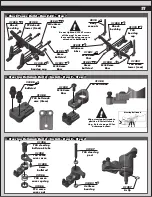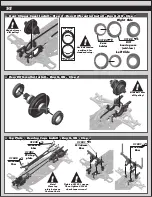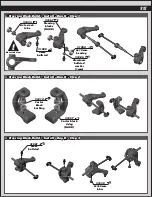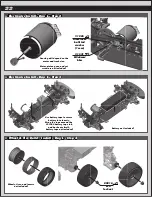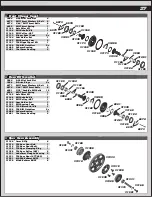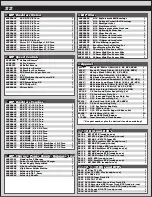
23
:: Tuning Tips
Tips for Beginners:
Before making any changes to the standard setup, make sure you can get around the track without crashing. Changes to your car
will not be beneficial if you can’t stay on the track. Your goal is consistent laps.
Once you can get around the track consistently, start tuning your car. Make only ONE adjustment at a time, testing it before making
another change. If the result of your adjustment is a faster lap, mark the change on the included setup sheet (make additional
copies of the sheet before writing on it). If your adjustment results in a slower lap, revert back to the previous setup and try another
change.
When you are satisfied with your car, fill in the setup sheet thoroughly and file itaway. Use this as a guide for future track days or
conditions.
Ride Height:
The standard starting point for ride height is 5.0mm (keep in mind that your local track may have minimum ride height
requirements). You can slightly raise the rear relative to the front to give the car more steering. Raise the car slightly for tracks
with large bumps.
Battery Placement:
For most cases, run the battery in the standard forward position. Typically this will be the most stable and easiest to drive. Try
moving the battery back if you encounter a low traction surface.
Ackermann & Steering Rate:
Ackermann refers to the relative angle difference between the front wheels as they are
turned to steer the car. The outside wheel will turn less than the inside wheel in most
conditions. Settings with more Ackermann will have a bigger difference in wheel angle,
causing the outside wheel to turn less. Likewise, settings with less Ackermann will cause
the outside wheel to turn more.
Increasing the Ackermann will smooth out the steering and is used most often on high
traction surfaces such as carpet. This is a result of the reduced outside wheel angle.
Settings with reduced Ackermann will help to increase corner entry steering, and are
typically used when running a spool in the front.
The steering rate is also adjusted when changing the length
of the steering bellcrank. There are three rate options. The
shortest position (position C) produces a slower speed than the
longest position (position A). Slower steering rates will make
the car less aggressive, making it easier to drive. These
settings are good for high traction conditions such as carpet.
The chart to the right lists the different Ackermann options along
with their associated steering rates.
Steering
Link
Steering
Bellcrank
Steering
Speed
Fast
Fast
Slow
Slow
Slow
Slow
Fast
Medium
Medium
Medium
Fast
2B
7A
2B
8A
1B
7C
2B
8B
2A
7A
2B
7C
1A
7C
2A
7B
2A
7C
Slow
2A
8B
2A
8C
Slow
1B
8C
2B
7B
2A
8A
2B
8C
1A
8C
Slow
Medium
Slow
More A
ckermann
Less A
ckermann
Wheelbase:
Lengthening the front will reduce steering, shortening the front will increase steering. Shortening the rear will
increase rear grip, lengthening the rear will decrease rear traction.
Wheel Base Shims
1mm
2mm
Rear Toe-In:
Decreasing toe-in will decrease rear traction and increase corner speed. Use numbered toe shims for adjustment.
1º
1.5º
2º
Arm Mount Shims
Steering Bellcrank
7
8
A
B
C
A
B
2
1
Steering Link
Содержание RC10TC6
Страница 1: ...8 11 ...
Страница 34: ...34 Notes ...



